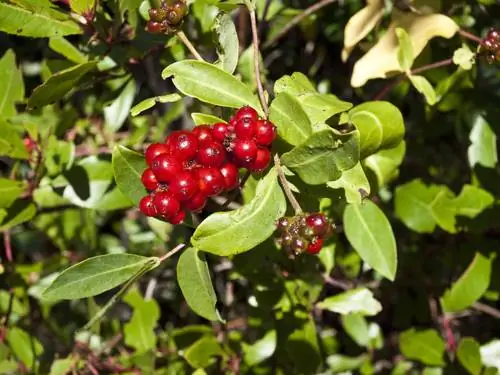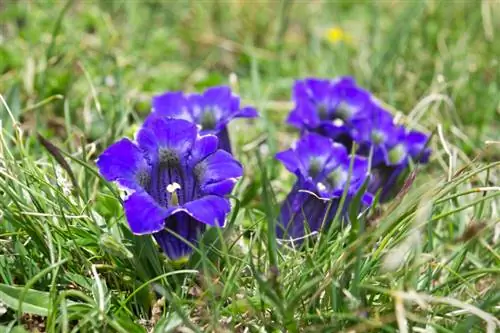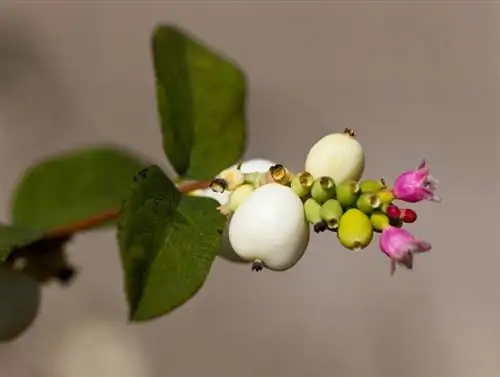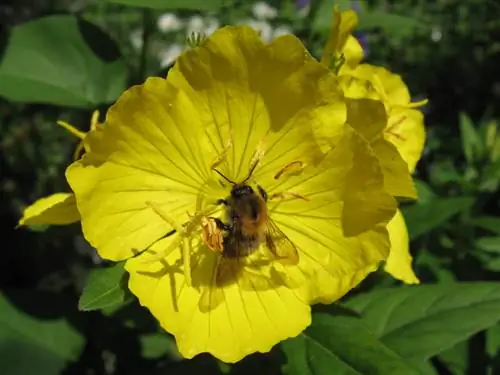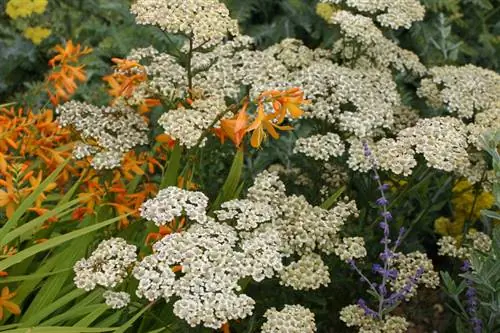- Author admin [email protected].
- Public 2023-12-25 17:45.
- Last modified 2025-01-23 11:22.
Modesty is the trump card for honeysuckles when it comes to care. In contrast, the ornamental tree has plenty to offer when it comes to the splendor of flowers and autumnal fruit decorations. The following answers to frequently asked questions show you how to properly care for this universal talent.
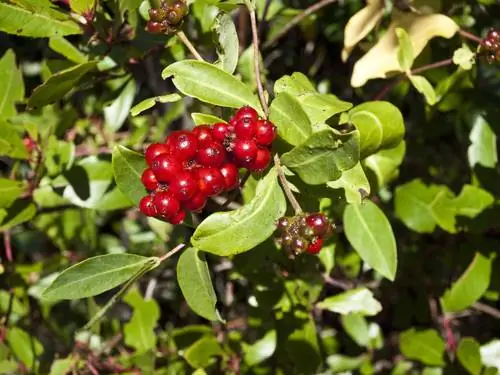
What are the care instructions for a honeysuckle?
The honeysuckle is an easy-care ornamental tree that blooms from May to June and produces berries in autumn. For optimal growth, it requires a sunny to partially shaded location, nutrient-rich and well-drained soil as well as regular fertilization and, if necessary, watering in dry conditions.
Planting honeysuckles correctly
In September and October there is a lot of activity in tree nurseries because now is the time to plant the most beautiful ornamental trees. If the honeysuckle comes into the ground at this time of year, the shallow roots find perfect conditions for vital growth. You can do it in these steps:
- Create spacious planting pits at a distance appropriate to the variety
- Enrich the excavation with sifted compost, leaf mold and horn shavings
- Place a potted root ball in the middle of each hole
- Fill with substrate that reaches just below the first pair of leaves
- Do not plant deeper than the honeysuckle was grown in the nursery
Watering generously and spreading a layer of mulch consisting of leaves, grass clippings or bark mulch sets the stage for vital rooting until the first frost.
Care tips
In order to properly care for a honeysuckle tree, no extensive previous gardening knowledge is required. The care program is so clear:
- Water during summer droughts and winter frosts
- Start the season with starter fertilization in March
- Then fertilize organically with compost and horn shavings every 14 days until August
- Pruning either after flowering or in late winter
Young honeysuckles require winter protection in the planting year by covering the young roots with leaves or brushwood.
Which location is suitable?
Situated in the right location, the maintenance effort is reduced to a minimum. Although the honeysuckle thrives in almost all locations, it shows its most beautiful side under the following conditions:
- Sunny, semi-shady location up to light shade
- Nutritious, humus-rich and fresh, moist soil
- Loose, well-drained and without waterlogging
- Slightly acidic, neutral or minimally alkaline pH value
Consequently, the ornamental tree is an excellent choice when long hedges extend over a distance with different lighting conditions.
The correct planting distance
A majestic honeysuckle with a height and width of up to 400 cm requires a planting distance of 250-300 cm to form an opaque hedge. More delicate trees come into their own with three plants per meter. The rather dwarf hedge myrtle forms a continuous row of plants if 5 to 7 specimens are planted per meter.
When is flowering time?
The majority of honeysuckle species and varieties resulting from them present their pretty flowers from May to June. Lonicera kamtschatica surprises with an extra early flowering from March, which subsequently produces edible berries from June onwards. So that you don't have to miss out on decorative splashes of color in the garden during the cold season, the winter honeysuckle is available with a flowering period from December to April.
Cut honeysuckle correctly
Your cultivation intentions define the choice of the optimal time for pruning a honeysuckle. We have put together the central premises below for your orientation:
- Pruning immediately after flowering if the growth of poisonous red berries is not desired
- Alternatively, cut the honeysuckle into shape in late winter, in time for the new shoots
Every year the lushly branching honeysuckle demands to be thinned out thoroughly. Regardless of when the topiary is done, we recommend cutting off all dead wood at the base in February/March. At the same time, frozen shoot tips can be shortened down to he althy wood.read more
Watering honeysuckle
Under normal weather conditions, watering cans or garden hoses are rarely used. Experience has shown that rainfall covers water requirements. Only during very dry summer periods should you water the honeysuckle thoroughly in the early morning or late evening. Overhead irrigation should be the exception, as the rippling water impairs the beauty of flowers and fruits and encourages fungal diseases.
Fertilize honeysuckle correctly
A regular supply of nutrients gives a honeysuckle tree enough energy for rapid growth, opulent flowers and numerous berries. A mineral-organic booster fertilization with complete fertilizer in March gets the tree on track. Afterwards, 14-day doses of compost and horn shavings ensure a constant supply of food to the roots. Stop fertilizing in August so that the shoots can mature in time before winter.
Wintering
Mostly the types and varieties of honeysuckle are completely hardy. In the year of planting, we still recommend light winter protection for the young roots. If you cover the ground with coniferous twigs or leaves, frost and constant winter wetness cannot cause any damage. After a harsh winter, the shoot tips are often frozen back. Thanks to the first-class pruning tolerance, this shortcoming is remedied by pruning. Please remember that some trees retain their foliage until late winter or thrive as evergreens. Therefore, there is still a need for watering if there is no rain or snow.
Propagate honeysuckle
The uncomplicated care of a honeysuckle is rounded off by the equally uncomplicated propagation. You can grow additional specimens using cuttings without much fuss. To do this, cut 10-15 cm long, half-woody shoots in summer. These are stripped of their leaves in the lower half and then planted in pots with a poor substrate. If kept constantly moist in a partially shaded, warm location, rooting takes place quickly. By autumn, a cutting has transformed into a vital young plant and can be planted out.
Is honeysuckle poisonous?
A honeysuckle with red or black berries comes across as a poisonous beauty. Various toxic ingredients are responsible, such as saponins and alkaloids. So that you don't have to do without the robust, easy-care flowering and fruity tree in your family garden, species and varieties with blue berries serve as a sensible alternative. These fruits are not particularly tasty. At least they pose no he alth risk to humans or animals.read more
Beautiful varieties
- Arnold Red: Tartarian honeysuckle with blue-red flowers and deep red berries; Growth height and width up to 400 cm
- Clavey’s Dwarf: Densely bushy variety with a rounded stature, white-yellow flowers and red fruits; Growth height 150-250 cm
- Winter honeysuckle: Impressive rarity with creamy-white flowers from December to April; Growth height 200-300 cm
- Slope myrtle: Evergreen creeping honeysuckle, ideal for greening slopes and as a ground cover; Growth height 50-80 cm
- Polar Bear: Honeysuckle with edible, blue berries and early flowers from March, beautiful in the pot; Growth height 100-150 cm

